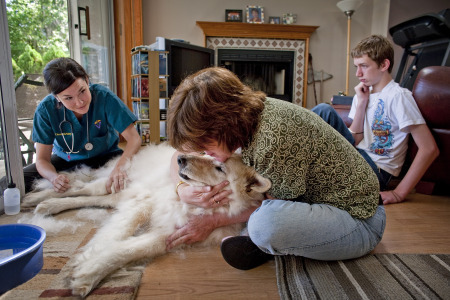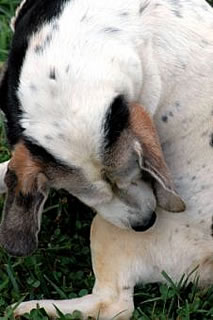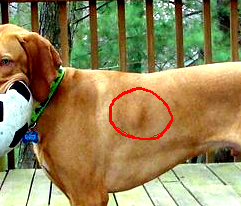
There is a growing trend in veterinary care – home hospice and home euthanasia for pets, and I, for one, am happy to see these services being offered on an increasing basis. Today there was an article in our local paper about one such veterinarian in the Tampa Bay area that gives a glimpse into a ‘day in the life of a home hospice/euthanasia veterinarian’:
From the Saint Pete Times – April 19, 2010
By Alexandra Zayas, Times Staff Writer
An hour before, Dr. Dani McVety begins to prepare. “Come on, girls,” she calls to her two rat terriers, “in the crate. “You too, Foose.” A big, brown mutt settles into the third cage in McVety’s Lutz home as she shuts the door and heads out to the garage. She pulls a green scrub shirt over her head, opens her trunk and unlocks a black box to reveal liquid-filled bottles. She inserts a syringe in one and slowly extracts a pink fluid, the last she’ll use today. It’s part of a list of things she does before she gets to someone’s home, things she doesn’t want them to see. She also fills out their authorization form in advance, because she has seen how hard it is to write with shaking hands.
As a rule, she never arrives early. So she heads to Starbucks first and orders a dark cherry mocha — decaf, because she and her husband just found out she’s pregnant for the second time.
In many ways, the 28-year-old veterinarian is just starting her life. Yet on this Monday morning, the career path she has chosen takes her to a Land O’Lakes home.
To end one.
• • •
McVety is a hospice veterinarian, part of a growing movement to revolutionize the way animals die. It’s modeled after human hospice, focusing on pain and grief management and creating a comforting scenario for families and pets when the end comes.
Some veterinarians have been doing these things for the past few decades, but hospice care is only now becoming a recognized field in veterinary medicine. It’s no surprise. Pets have evolved into family members, and better medicine means they’re living longer with serious illnesses. Meanwhile, more and more people have had good experiences with human hospice.
The demand is high. McVety performs five in-home euthanasias a week. In one day this week, she had four. When she graduated from the University of Florida’s vet school last year, she never imagined this would become her job.
She grew up with horses in Odessa, wanting to become an equine veterinarian, but shifted to a different kind of pet care because she preferred the connection she felt with owners of dogs and cats. She knew losing animals came with saving them, but she dreaded her first death.
She was at the Tampa Bay Veterinary Emergency Service on Bearss Avenue when she realized she had a talent for dealing with people in pain. A woman came in at 8 p.m. with a cat that had only hours left. The woman insisted her cat could not die that day, the one-year anniversary of her last cat’s death. She said she didn’t know how she could drive home, but told McVety she wanted to leave the cat there, and asked the doctor to call when her pet was dead.
McVety told her she needed to stay. Her cat needed her. At 12:01 a.m., they put the cat to sleep. And the woman, who had the time she needed to say goodbye, was able to drive home. All she needed was for it to happen on her terms.
The doctor saw herself in the grieving pet owners who walked into the clinic night after night. She was a year or two into college when her childhood dog, Dusty, developed such severe arthritis she couldn’t stand. The family had to pick up the 80-pound Doberman, put her in the car and unload her at the clinic. McVety already had enough medical knowledge to know how much pain that caused Dusty.
She remembers walking into the waiting room and having to pass a bouncing puppy. Seeing the doctor for two or three minutes. Wishing she could hold her dog, but not being able to because of where the IV was placed.
Wanting to rip the tube out of her dog’s leg once it was over.
In August, she started a hospice practice. She settled on a name after watching a chihuahua die curled up in a woman’s lap.
She called it Lap of Love.
• • •
McVety runs her hand through the thick white fur of a German shepherd sprawled by the sliding glass door of a lakefront Pasco County home.
“He’s gorgeous,” McVety says.
His name is Rudy. He is 14 years old. He has arthritis, bad hips and tumors throughout his body. His hearing and sight have faded and he can’t stand up or hold his bladder. His family — Judy Turner, her husband and their 14-year-old son, Jacob — scheduled this visit weeks ago to fall on spring break.
They feel like they’ve waited too long.
They tell McVety about Rudy, the way he used to dip his paws in the swimming pool, as if he were soaking his nails. The way he used to squeeze out of the yard when they were gone, but return just before they got home. The way he wouldn’t go into the house before each one of them was inside, safe.
“He’s as old as I am in human years,” Jacob says. When they first met, he was a baby, and Rudy was a puppy.
McVety asks what they’d like inscribed on the box that will hold his cremains. Judy Turner begins to cry.
“My big old polar bear,” she says.
Turner finds her place on the floor, just over Rudy’s head. She leans over and rubs his belly.
“Yeah,” she tells him, “give us a grunt. Yeah, yeah, you’re a big old polar bear … “
McVety explains that the first injection will be a sedative. It startles Rudy, who gets restless. Turner holds him tight.
“That’s your back yard out there,” Turner says. “Look at that, chasing all those balls out there, bringing them back. You’re a good boy.”
Rudy slows down, his gaze fixed outside. The sky is a bright blue. Leaves swirl in the swimming pool. He begins to fall asleep.
McVety shaves a patch in one of his hind legs. It reminds Jacob of the time his dad cut Rudy a lion’s mane, and the time they sculpted his fur to look like a poodle.
“You sleepy, Rudy?” Turner asks. “You fallin’ asleep on me?”
It’s time.
“Please stop me if you don’t want to hear this,” McVety says. “The drug we use is sodium pentobarbital. It’s a drug overdose of pain medication. It’s very painless. It affects the brain before it affects the heart …
“I think he’s ready,” McVety says.
The last time the Turners put a dog to sleep, Jacob was a baby and Judy had to step out of the room to tend to him. By the time she returned, the dog was gone. The doctor hadn’t told them what was going to happen before it already had.
Turner answers, “I think he’s ready, too.”
Jacob stares at the pink fluid flowing into his dog as Turner keeps talking.
“You’re okay, buddy boy. You’re just fine. You always do things well … “
Rudy breathes deep.
“You’re such a dignified creature. Look at how dignified you are.”
He’s still.
“So well done, Rudy. So well done … “
McVety whispers, “He’s gone.”
• • •
(To read the rest of the article, click HERE.)
To find out more about home euthanasia and to locate a veterinarian in your area that provides this service, visit VetLocator.com and enter your zip into our Quick Search directory and click Search. On the left of the page click on Advanced and select Home Euthanasia, then scroll to the bottom and enter your zip again.
Warmly,

Daily Paws
www.vetlocator.com
![Reblog this post [with Zemanta]](http://img.zemanta.com/reblog_e.png?x-id=177cf379-b466-87e2-a9c1-4a33152f66a9)


![Reblog this post [with Zemanta]](http://img.zemanta.com/reblog_e.png?x-id=ae05e61f-f781-8336-be9a-97c53dd1829f)

![Reblog this post [with Zemanta]](http://img.zemanta.com/reblog_e.png?x-id=3ef26ab4-7ce2-46b2-96eb-3c4549dd046f)

![Reblog this post [with Zemanta]](http://img.zemanta.com/reblog_e.png?x-id=1b67ea46-5fb3-41ca-8ffa-db282601ddd7)


![Reblog this post [with Zemanta]](http://img.zemanta.com/reblog_e.png?x-id=6ef493af-40cf-4253-a254-fb552ce06ff7)



